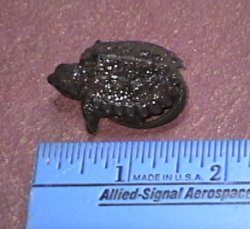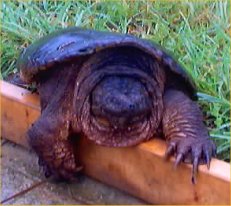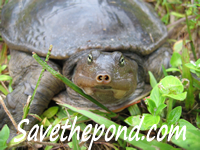 |
 |
|
|
Last Updated: 3/4/11
View comments, photos, and stories relevant to this page.




Snapping Turtle Species
Comparison Table of Common and Alligator Snappers
Snapping Turtle Care
Trapping Snapping Turtles
More on Yolks and Wild Snapper Nests
Snapping Turtle Photos
My Snapping Turtle
Snapping Turtle Links

Regular snapping turtles belong to the genus Chelydra, and alligator snapping turtles belong to Macroclemys. There are three snapping turtle sub-species: the common snapper, the Florida snapper, and the South American snapper. These are not turtles that you would purposely set up a pond for unless you were a true turtle enthusiast interested in snapping turtles. Because they eat all sizes of fish, they are only suitable for large natural ponds. Chelydra serpentina, or the common snapping turtle, is often misjudged. Yes, it can bite; yes, it can eat fish; but no, it is not the end of your pond or getting in the pond. They only bite if you step on them or get too close. Snapping turtles hide in the bottom mud and ambush their prey. Rarely do they bask or get out of the water (except females laying eggs). They will not come after you in most cases (each one is an individual as with most animals). Snapping turtles can eat fish almost as big as they are but probably will not eat too many. Set out a baited trap (see links below) and relocate any turtles many miles away in more suitable habitat if your pond is not large enough for them (>10,000 gallons or so?). Their carapace is 10 to 18 inches long, and they can grow to 35 to 60 pounds. Most average 10 to 35 pounds and 8 to 19 inches long. But some get huge! One large pond owner in Canada saw a goose get pulled under and torn up, found dead deer, and saw massive surface rippling. Finally, a local agency caught and removed the culprit, a 54 pound snapping turtle!! Alligator snapping turtles (Macroclemys temminckii) in the South can grow to 200 pounds and 26 inches long! Common snappers eat plants, fish, crayfish, ducklings, and all sorts of animals. Basically, anything that they can catch will get eaten. I guess alligator snappers eat whatever they want! Females lay 25 to 50 round eggs in early summer.

Below is a table comparing some of the basics for common and alligator snapping turtles.
| Common Name | Latin Name | Adult Size | Mating Season | Laying Season | Clutch Size | Incubation Period | Other |
| Alligator Snapping Turtle | Macroclemys temminckii | Up to 300 pounds, 31 inches long | February to May | Late spring to early fall | 6 to 80+ (depends on her size) | 3 to 4 months in nature; 82 days at 86 degrees F in an incubator | |
| Common Snapping Turtle | Chelydra serpentina | Up to 86 pounds, 20 inches long (usually 12 inches) | Spring | Spring | 8 to 30+ (depends on her size) | 50 to 100 days (temperature dependent) | Newborns may overwinter in nest |

The main thing to know about snapping turtles is that they need a lot of room and may consider anything food! More people than you would think keep snapping turtles as pets, indoors and out. They will grow larger and be more healthy in ponds or at least larger aquariums (over 100 gallons).
If you want to keep one as a pet or have one, see The Snapping Turtle Website for the best collection of information on how to care for snappers.
I had a baby common snapper for 7 months and never noticed a smell but I have gotten many e-mails from people saying that snappers stink horribly and how could I stand it! Well, I guess the adults stink. I am not sure why. If you know, let me know! Perhaps they have a musk-type gland. If you encounter a large, plated, long-tailed, snappy, and stinky turtle, it is a snapper.

Some people find snapping turtles in their ponds. The smaller the pond is, the more impact a snapper will have as far as eating prized fish, frogs, etc. For this reason, those of us with small ponds meant for fish probably will want to remove a snapper if it decides the pond is his/hers.
To deter snappers from entering a pond, the pond can be fenced or have an elevated rim. The fewer potential food sources (fish, frogs, ducklings, etc.) there in the pond, the less appealing it will be.
To avoid being bitten by snappers in swimming ponds, farm ponds, etc., instruct children and adults to shuffle when they walk instead of lifting their feet. It is a good idea to wear beach shoes or flip flops so you do not cut your feet on things on the bottom. If you shuffle into a snapping turtle, it will move. If you step on one, it may bite and could be hurt.
Here are two links dealing with trapping turtles:
Commercial turtle traps
Trapping
Snapping Turtles - includes how to make your own trap and many links to turtle trap-related
sites.

Gail found a big nest of snappers and asked me a ton of questions in early October 2004. I thought I should add more here on natural nest behavior for the hatchlings. When they hatch, snappers still have some yolk hanging from their tummy. For a few days and perhaps weeks, the babies in nature would stay down in the nest (that is under the ground) absorbing their yolks. Once the yolk is inside them, they can still feed from it for a week or more. Once the yolk is no longer hanging out of them (and cannot be punctured), the babies will emerge from the nest. They prefer to do this at night and in groups, instead of alone. If it is already really cold, they may simply spend the entire winter down in the nest, below the frost line where they will not freeze. Gail had found baby snappers running around into the road and wanted to move them and unhatched eggs as well so they dug them out of the ground and some babies even came out of the egg early. Baby turtles (as well as other animals from eggs) normally should not be helped out of the egg. This can result in injury, improper hardening of the bones, and other problems. The babies that Gail took from the ground were lethargic, weak, and had yolk sticking out some. Such babies should be kept in a safe place until the yolks are internalized, and they are stronger. This may take a week or so. Once the yolk in inside, the turtles will move about but do not need to eat right away. They will try to find a water source and a hibernation site (and hopefully avoid predators) before it gets too cold. Most wild snapper nests hatch in September but some in October.
A lot of this section also holds true for other species of turtles.

Photos are listed from oldest to newest.
I went to the zoo on 6/7/06 and took this photo of a basking
snapping turtle some 500 feet away. Snappers rarely bask. I cropped off the extra in the photo so
it is just the turtle, a little fuzzy.
Basking snapping turtle.
To see photos of the baby snapper I had for less than a year, go to Snappy's Page.
To see photos of other baby snapping turtles, go to the baby turtle photo page.
A few photos of an adult snapper are at the top of this page.
Alexis sent these photos on 4/29/07 of a snapping turtle that she found in West Chester, PA
named Diggster:
Diggster - top view
Diggster - side view
On 6/13/08, my father found a baby snapping turtle by our pool! This was the first turtle that was
not a box turtle ever seen on our land. His shell length was 3" but with a 3" head and neck and
3" tail, his entire length was closer to 9". Since we did not want him moving in to my pond
(where he would do very well and not cause problems for a few years when he would start eating
too many of my fish and frog buddies), my mother wanted to release him at a lake a few miles
away. Since she was "too busy," I kept him a few days and took photos. I fed him mealworms
and crickets which he liked. He was set up in my basement pond (that was empty) with two
bricks on which to bask, a hardware cloth lid, and a heat lamp. I did not put in a filter, heater,
etc. for such a short stay.
Baby snapper
Baby snapper
Baby snapper
Baby snapper - in the temporary setup
with a cricket
On 6/15/08, I released the baby snapper at a local pond. Here are some more photos.
Snapper - top view
Snapper - close-up of the head
Snapper - bottom view; note how his
plastron gives him more leg room than most aquatic turtles.
Pond - a view of the pond where I
released him from close up; you mostly just see cattails.
Snapper - good bye! He is digging in
to the mud to his new home.
Pond - a final view of his new pond
from the top of the hill
On 10/16/08, we went to Meadowlark Botanical Gardens. In one of their large ponds was the
biggest snapping turtle I have ever seen! This guy was at least 1.5 feet long not including the
long tail! He was covered in hair algae. To see other photos from the gardens including other
species of turtles, go to this
page.
Massive Snapping
Turtle
Massive Snapping
Turtle
Massive Snapping
Turtle
On 6/1/09, Ryan sent these photos of an 18" female snapping turtle that laid eggs in his yard.
Female snapping turtle- back view
Female snapping turtle- in a hole
On 6/8/09, Jennifer sent these photos of a medium-sized female snapping turtle that was in her
yard to lay eggs:
Female snapping turtle
Female snapping turtle
Female snapping turtle
Female snapping turtle
Female snapping turtle
Female snapping turtle
Female snapping turtle
On 8/19/10, four years after the above photo of the snapping turtle at a pond at the Maryland
Zoo, we returned to find perhaps the same turtle basking just the same!
Snapping turtle basking from a
distance.
Snapping turtle - close-up of the
previous photo.
Snapping turtle basking from a different
view (just the close-up).
Snapping turtle at the World of Pet's Expo on 1/29/11.

To read about the baby snapper I had for less than a year, go to Snappy's Page.

Check out The Snapping Turtle Website for lots more on snapping turtles!
Another good site on basic snapping turtle information and care is found at Turtle Homes. There are apparently a lot of people who keep snapping turtles as pets, some of whom later regret it and some of whom spend thousands of dollars on huge appropriate setups for these big, bitey turtles.
Yet another snapping turtle site is Snapping Turtle Land. (It does not seem to have anything on it but the main page now, 1/19/06?)
Here is the Chelonia.org care sheet on snapping turtles.
Grizzly Run Snapping Turtle Page
Snapping Turtle Hatchling Video - Don had 50 baby snappers in 2008 that he was raising!

|
|
|
Return to the main turtle page. See the master index for the turtle pages.
|
Click below to vote for Robyn's Turtle Pages as a Top Turtle Site!
|

|

|
E-mail RobynCopyright © 1997-2026 Robyn Rhudy |

|
 |